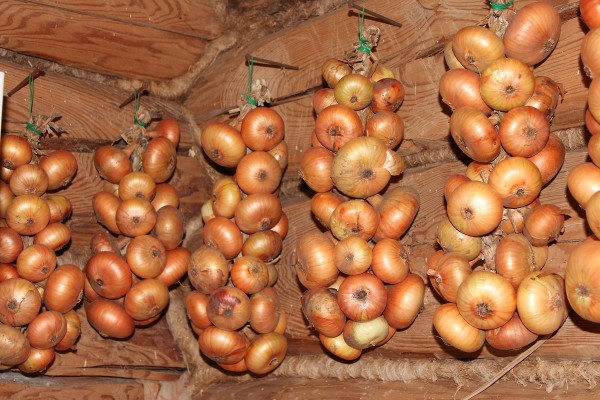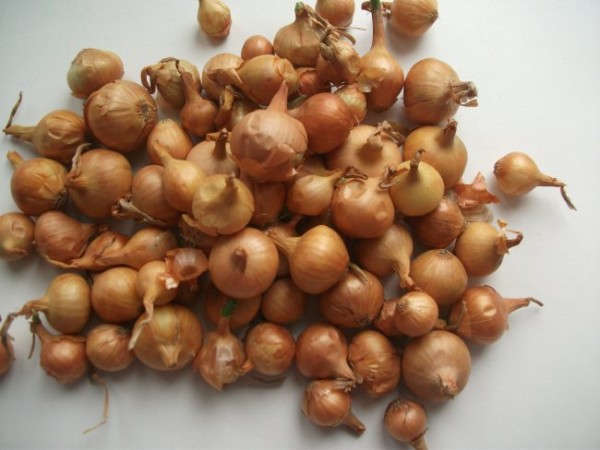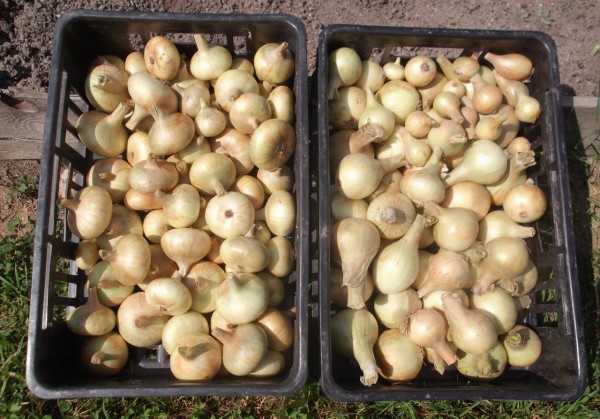How to keep onions fresh and edible until spring
Content
What varieties can be stored
If you really grow onions on your site, then you need to choose the varieties so that you can eat it all year round. For this, varieties are planted that ripen during the summer. For long-term storage for the winter, late-ripening varieties are chosen, and the bitter onion is better preserved, the sweeter it is, the faster it needs to be eaten.
So you can save the harvest of the late-ripening Snowball variety until spring. Its juicy, round white onions can be added to salads all year round if stored properly. Golden-brown spherical bulbs of the Farmer Pozdny variety are also designed for long-term storage. Their sets are also well kept.

The “Volzhanin” variety can be stored for up to 9 months without any losses, regular-shaped bulbs, covered with golden dry husks, are distinguished by white pulp and sharp taste. "Setton", "Galileo", even "Studgarter Riesen", grown from sevka, can easily stay over the winter, if the conditions are good. But the varieties "Strigunovsky local" (it is also recommended to grow from sevka) and "Kaba", although late-ripening, it is better to use fresh.
Onions of the "Kaba" variety are considered one of the best in terms of their taste, but their loose structure does not allow to feast on them in winter. If you create ideal storage conditions, you can save your crop until the new year. The ripe harvest of "Rostovsky", "Mstersky", "Krasnoyarsky", "Arzamazsky", "Bessonovsky", "Balakleevsky" varieties of hot onions, as well as their sets, is well stored. Late-ripening leeks, for example, "Karantansky", "Elephant", can also be stored until spring, but their greens are slightly tougher and spicy compared to those that ripen earlier.
Preparing stocks for storage
To prepare the crop for storage, they begin with harvesting it. Onions are chosen at different times, depending on the ripening time of each variety, but most often this happens in August. When fully ripe, the onion sheds its feathers, its neck becomes thinner and dries up. This event is best done on a dry warm day, starting in the morning. Only fully matured specimens without mechanical damage will be able to save for the winter. That is why they cannot be pulled out, thrown, but you only need to dig a little (usually this is done with a pitchfork), carefully remove them, clean them with your hands and put them to dry.

Onions are dried together with leaves in the fresh air, if the weather permits, otherwise they are laid out or hung in small bundles under the roof: in the yard, on the veranda, balcony, in the barn. If the crop is very small, you can carefully dry the bulbs using the oven, for this you need to keep the temperature no higher than 40-42 degrees, keep the oven ajar, or open it often for airing. Dried onions are cut with scissors - the roots are shortened carefully so as not to catch the bottom, and the leaves are cut off, leaving 4-6 cm.
Only after that the onions are sorted out, and the strongest medium-sized bulbs are sent for long-term storage without mechanical damage. The largest and smallest are determined for use in the near future. Those that are slightly larger than sets can be planted in the fall along with the early varieties - they can be eaten in the summer before the spring plantings mature.
Leeks are usually harvested as a whole plant or in separate leaves. Fresh green leeks can be cut all summer long if frozen for later storage in the refrigerator or dried like any herbal seasoning. To do this, the green leek leaf is carefully cut off, all dry or damaged areas are removed, washed and dried, spreading in a thin layer on a dry, clean cloth. Dried leaves are cut into convenient parts (rings, straws, large pieces), frozen and kept in the refrigerator all the time.

Sometimes gardeners cover the leek with a special covering material (or just a film, which is not so effective) so that it stays green and fresh for a long time. But it still cannot withstand severe frosts, and in order to preserve and feast on them in winter, it is better to harvest before the frosts. Harvesting and preparing for long-term storage of leeks is no different from preparing onions. It is just as carefully undermined, taken out, cleaned, roots are cut. You do not need to cut the leaves, this can lead to rotting of the stem.
Video "Onion storage technology»
Recommendations for storing onions at home, which will help to avoid spoilage and rotting.
Storage conditions
Onions are usually stored in the basement, and if they are not there, then simply in the apartment. In order for it to survive at home until spring, certain conditions must be observed: monitor the temperature and humidity. Onions can dry out if there is a lack of moisture and rot if there is an excess of it. If the temperature drops too low, it will simply freeze and lose most of its useful and taste qualities. If it is too warm, it will grow. None of this will happen if you store it properly.
In the apartment
If an apartment is the only way to store onions, then you need to find a place where fresh air enters, but the temperature does not go beyond 18–22 degrees. The humidity for storage at home should remain in the range of 50-70%. This can be an unheated storage room or just a place near the balcony (but not near the battery). On the glassed-in balcony, you can cover the bow so that it can hold out there until severe frosts.
If you do not cut the leaves and braid the onions in braids, then hanging it is convenient to store it in the attic or even in the kitchen. So he decorates the interior and protects residents from viral diseases thanks to his phytoncides. Leek on the balcony in a sheltered state tolerates temperatures of 7-10 degrees.
Fresh green leeks with leaves can be stored for up to 5 months in the refrigerator. To do this, it is cooled to a temperature of –2 degrees, then put into a chilled perforated bag and left at a temperature not lower than –5. A green fresh leaf (without a stem) is cut into small pieces, folded in a thin layer in plastic bags and frozen in the freezer, and left there until use.

In the basement
Of course, it's best to store your crops in a basement. Sweet and semi-spicy varieties require temperatures from 0 down to –1, acute ones feel comfortable up to –3 degrees. Humidity should be maintained at 75-90%. This is important, because with a lower humidity, the onion will simply dry out, and with a higher humidity, it risks rotting. There should be no other vegetables nearby that require different conditions.
If the moisture is excessive, it can be reduced by placing boxes of ash next to the vegetables. It is recommended to sprinkle onions lightly with chalk to protect them from decay. Once every 2-3 weeks, you need to check the condition of the onion, remove the spoiled specimens in order to save the rest from the same fate.
Leeks are best stored in wet sand. 5 cm of sand is poured into the box, plants are placed in rows on top and another 15-20 cm of wet clean sand is added. So it can be stored for up to 5 months and will always be green, juicy and tasty. It is worth recalling that the harvest is added to the basement only if wet cleaning and airing have already been carried out there.

What is the best way to store
Onions are stored in boxes, boxes, baskets, wicker nets, even nylon stockings. Proper storage at home means providing fresh air. Racks are suitable for storage, the onion layer should be no more than 40 cm. Boxes and boxes must necessarily have holes, they are placed in basements not on the floor, but on wooden supports. Small trays are used to store the seed, they are placed vertically, but not tightly. Turnip, leek, set - any onion is kept fresh for a long time under the right conditions.
Video "How to store onions correctly"
Tips for proper onion drying, caring for it, as well as creating all the necessary conditions for storing it during the winter.

